Table of Contents
Are you interested in on-demand delivery app development?
With the sudden growth in on-demand industry and on-demand solution companies generating billions, the market has attracted attention from across the world.
Uber, Zomato, and InstaCart, all fall in this industry.
Well, there are a lot of people who want to develop on-demand delivery apps. Now, if you are one of these, this blog is for you.
Here, we shall be discussing all you need to know about on-demand delivery app development. This covers everything from market statistics to types, reasons to invest, development process, cost and trends.
To end the blog and answer important questions, we shall also be discussing FAQs at the end.
Therefore, with this being said, let’s get right into it:
Growing Market for On-Demand Solutions
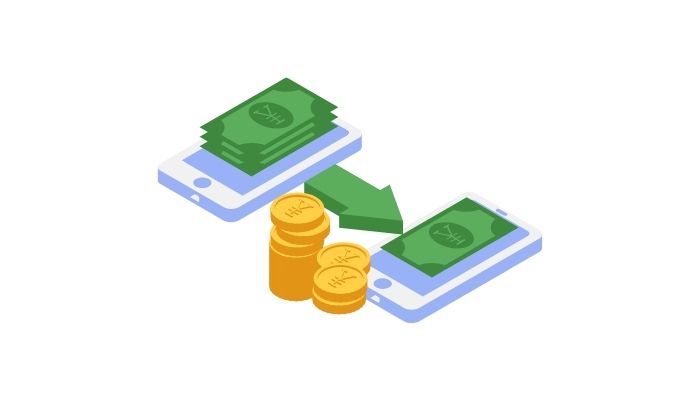
In a bid to understand on-demand delivery app industry, let’s start with statistical insights. These are, as mentioned below:
- The global On-demand delivery app market size is expected to reach $354.2 billion by 2027, growing at a CAGR of 8.95% from 2021 to 2027.
- The food delivery segment is the largest segment of the On-demand delivery app market, accounting for 44.2% of the market in 2021.
- The grocery delivery segment is the fastest-growing segment of the On-demand delivery app market, with a CAGR of 22.2% from 2021 to 2027.
- The average order value for On-demand delivery apps is $35.
- The average delivery time for On-demand delivery apps is 30 minutes.
- 60% of On-demand delivery users are willing to pay extra for same-day delivery.
- The most popular On-demand delivery apps in the world are Uber Eats, DoorDash, and Grubhub.
With this out of the way, we are going to take a look at overview of on-demand delivery app development.
What is On-Demand Delivery App Development?
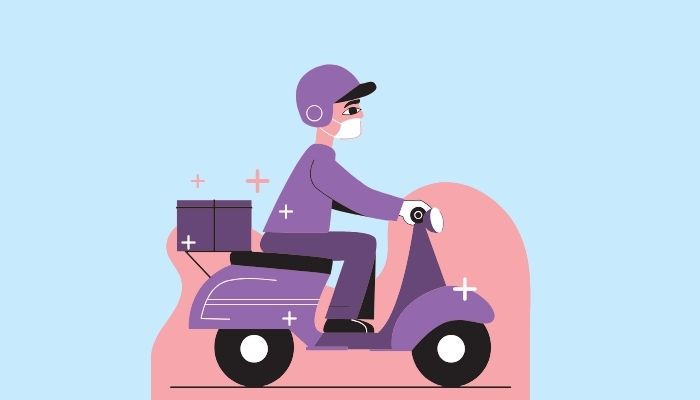
So, what is on-demand delivery app development?
At its core, on-demand delivery app development is about creating a platform that bridges the gap between service providers and users, all in real-time.
Moreover, these apps leverage cutting-edge technology, such as geolocation and secure payment gateways, to ensure seamless transactions and user experiences.
In technical aspect it’s no different from usual mobile app development.
The main difference lies in function of the solution. But that’s something that you have understood quite well now.
Moving on, on-demand delivery app development stands as umbrella concept housing range of other solution.
Spectrum of On-Demand Delivery Apps
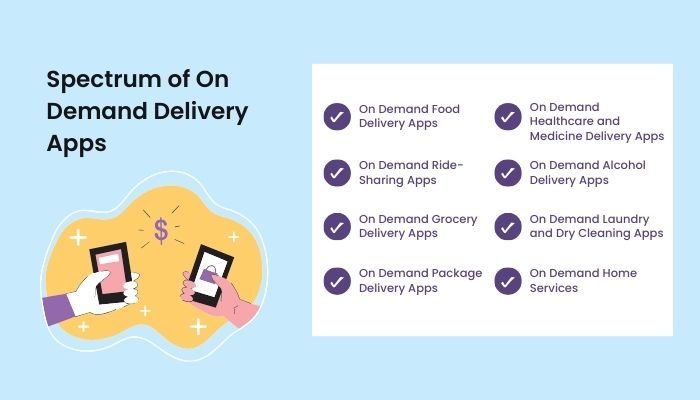
Imagine a world where your every need is just a few taps away on your smartphone – a world where convenience and instant gratification are the order of the day.
On-demand delivery apps have turned this vision into reality, offering a remarkable spectrum of services at your fingertips.
Here, we take a closer look at some of the most popular types:
-
On-Demand Food Delivery Apps
Picture those lazy evenings when you crave your favorite meal but don’t feel like going out or cooking.
Food delivery apps like Uber Eats, DoorDash, and Grubhub swoop in as your culinary saviors.
With a vast array of restaurants and cuisines to choose from, these apps ensure that your favorite dishes are just a tap away, arriving piping hot right at your doorstep.
Well, there are a lot of who want to food delivery business.
-
On-Demand Ride-Sharing Apps
Goes without saying, one of the most popular example of on-demand apps is, on-demand taxi app development
You see, while ride-sharing apps like Uber and Lyft are primarily associated with transportation, they’ve expanded their horizons into the realm of food delivery services.
So, whether you need a lift to a friend’s house or a gourmet burger from your favorite joint, these apps have you covered.
-
On-Demand Grocery Delivery Apps
Grocery shopping can be a time-consuming chore, but not with grocery delivery app development in the picture.
Moreover, services like Instacart and Amazon Fresh have revolutionized the way we shop for groceries.
You can now fill your virtual cart with fresh produce, pantry staples, and more, all without leaving the comfort of your home.
-
On-Demand Package Delivery Apps
Ever had a package you urgently needed to send or receive?
Now, you can enter package delivery apps offered by giants like UPS and FedEx.
You see, these apps streamline the process, allowing you to schedule pickups, track deliveries in real-time, and ensure your parcels reach their destinations promptly.
-
On-Demand Healthcare and Medicine Delivery Apps
Sometimes, health can’t wait.
Healthcare and medicine delivery apps step in to make sure it doesn’t have to.
Moreover, these apps let you order prescriptions and healthcare products hassle-free, ensuring you have the essentials you need when you need them.
In fact, it stands as one of the top 10 app development opportunities in North Carolina.
-
On-Demand Alcohol Delivery Apps
For those moments when you’re hosting a gathering or simply in the mood for a glass of wine, alcohol delivery apps like Drizly come to the rescue.
They specialize in delivering alcoholic beverages right to your doorstep, all while ensuring compliance with age restrictions.
Well, yeah, it might not be globally acceptable, but it’s good.
-
On-Demand Laundry and Dry Cleaning Apps
Laundry day need no longer be a dreaded affair.
You see, Laundry and dry cleaning apps, such as Rinse and Cleanly, make it as easy as requesting a pickup and having your freshly cleaned clothes delivered to your doorstep.
Furthermore, it’s like having your own personal laundry assistant.
-
On-Demand Home Services
Lastly, we have on-demand home services.
When your home needs a little TLC, home service apps like TaskRabbit come to the rescue.
Furthermore, they connect you with skilled professionals for a wide range of tasks, from home repairs and maintenance to furniture assembly and more.
Say goodbye to your to-do list woes.
Why You Should Choose On-Demand Delivery App Development?
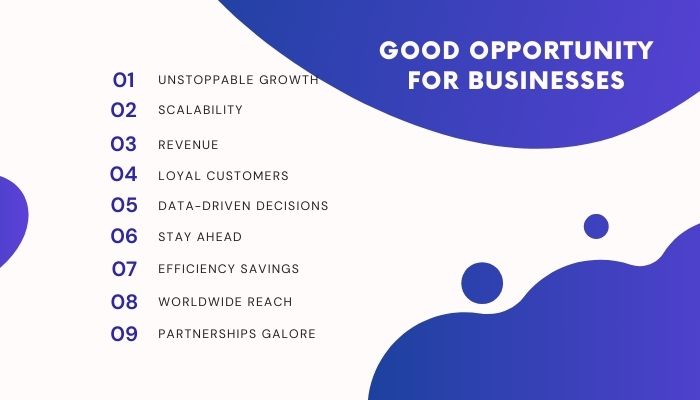
Here’s where the magic happens – why should businesses consider jumping into the on demand delivery app development arena?
Let’s break it down:
01. Unstoppable Growth
The On-demand economy is on fire. People want services at their fingertips, and businesses that provide this convenience are thriving.
02. Scalability
On-demand apps are incredibly scalable. As your user base grows, you can expand your services effortlessly.
03. Revenue
These apps offer diverse revenue streams, including delivery fees, subscriptions, ads, and commissions from service providers. The money-making potential is vast.
04. Loyal Customers
Offering hassle-free services creates customer loyalty. When users find what they need quickly, they’ll keep coming back.
05. Data-Driven Decisions
These apps gather precious user data. This treasure trove of information empowers businesses to make informed choices and personalize services.
06. Stay Ahead
Entering the On-demand space sets you apart from traditional competitors. It’s a chance to be a trendsetter.
07. Efficiency Savings
Automation and optimization reduce operational costs, giving your business a competitive edge.
08. Worldwide Reach
With effective marketing and technology, your app can reach a global audience, unlocking new markets.
09. Partnerships Galore
Collaborate with local businesses to broaden your service range. Partnerships can be mutually beneficial.
Things to Consider While Developing an On-Demand Delivery App
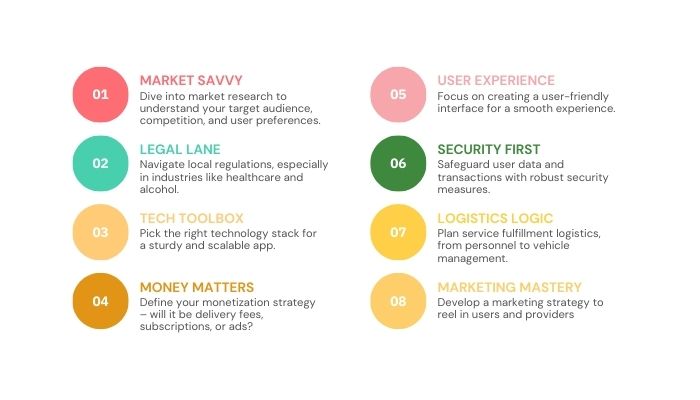
Before you go on and hire mobile app developers to start your own on-demand delivery app, there are a few things that you should definitely consider.
In this section of the blog, we shall be going through exactly that.
Therefore, let’s get right into it:
- Market Savvy: Dive into market research to understand your target audience, competition, and user preferences.
- Legal Lane: Navigate local regulations, especially in industries like healthcare and alcohol.
- Tech Toolbox: Pick the right technology stack for a sturdy and scalable app.
- Money Matters: Define your monetization strategy – will it be delivery fees, subscriptions, or ads?
- User Experience: Focus on creating a user-friendly interface for a smooth experience.
- SecurityFirst: Safeguard user data and transactions with robust security measures.
- Logistics Logic: Plan service fulfillment logistics, from personnel to vehicle management.
- Marketing Mastery: Develop a marketing strategy to reel in users and providers
On-Demand Delivery App Development Process
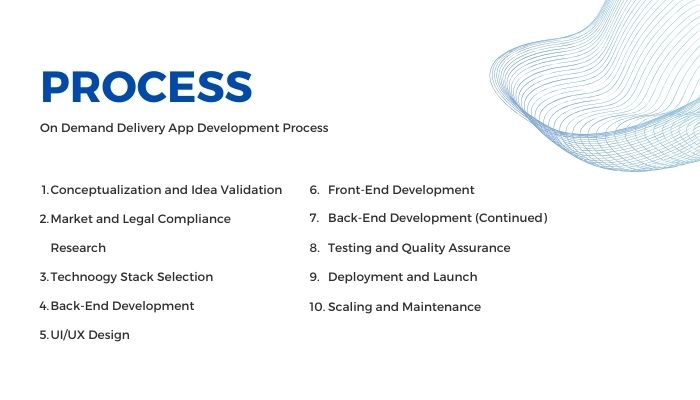
On-Demand Delivery App Development isn’t magic.
Rather, it’s a structured process that requires careful planning and a deep understanding of user needs.
Here, we’ll take you through each phase of the development process in detail:
A] Conceptualization and Idea Validation
We kick off with thorough market research to uncover gaps in the market and grasp user needs effectively.
Moreover, it’s like detective work – analyzing competitors, pinpointing what makes your app unique, and creating user personas to understand your audience better.
Plus, you should not forget to validate your concept with a test audience, gathering valuable feedback to refine your idea before going all-in.
B] Market and Legal Compliance Research
Now, we dive into the world of market regulations.
It’s like decoding a complex puzzle, as we scrutinize legal and regulatory requirements, especially for sensitive areas like healthcare, alcohol, and transportation.
Furthermore, we make sure to obtain all necessary licenses and permits, leaving no room for future legal headaches.
C] Technology Stack Selection
On the technical side, we face crucial decisions. For your app’s front-end (the user interface), we choose the right technology stack.
It’s like picking the perfect tools for an artist – options include versatile frameworks like React Native, Flutter, or platform-specific development with Swift for iOS and Java/Kotlin for Android.
D] Back-End Development
Behind the scenes, in the app’s back-end, we choose a technology stack that suits your project.
Think of it as building the engine for your app.
Moreover, popular choices include Node.js, Ruby on Rails, or Python with Django – all ensuring your app’s logic, databases, and servers run smoothly.
E] UI/UX Design
Crafting a user-friendly and visually appealing interface is paramount.
We collaborate with skilled designers to create wireframes and prototypes that ensure a seamless and enjoyable user experience.
Plus, think of it as designing a well-thought-out pathway for users from start to finish.
F] Front-End Development
Once we have the UI/UX designs in hand, our developers start bringing the front-end to life. In addition to this is where the chosen technology stack plays a pivotal role.
Our goal is to make sure that the design blends seamlessly with the app’s functionality.
G] Back-End Development (Continued)
In parallel, the back-end development work continues, focusing on building the server, databases, and application logic.
Plus, security measures are a priority, ensuring user data and transactions remain safe with robust encryption and authentication.
H] Testing and Quality Assurance
Rigorous testing is key.
Our quality assurance teams conduct comprehensive tests, including functional, usability, and performance tests.
In addition, identifying and fixing bugs and inconsistencies ensures a smooth, error-free user experience.
I] Deployment and Launch
After thorough testing, your app is ready for deployment.
It’s released on app stores, such as the Apple App Store and Google Play Store, making it accessible to users.
And we also strategize the launch to maximize visibility and downloads.
J] Scaling and Maintenance
As your user base grows, we’re ready to scale your infrastructure and services.
Regular maintenance keeps the app up-to-date, addresses issues promptly, and introduces new features to keep users engaged.
How Much Does it Cost to Develop an On-Demand Delivery App?
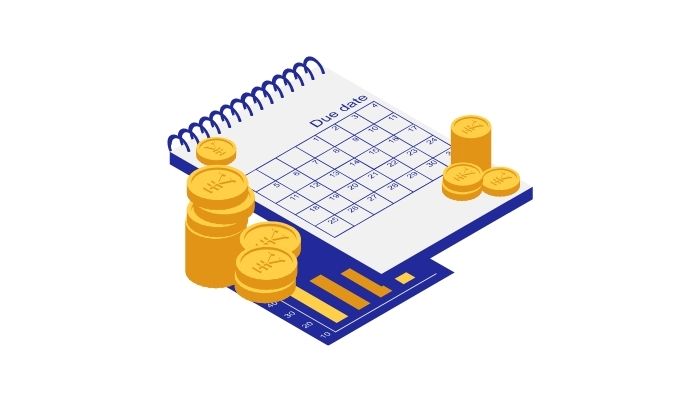
Now, let’s talk money.
The cost of developing an On-demand delivery app can vary.
Moreover, a basic version might start at around $20,000, while feature-rich apps can surpass $100,000.
Don’t forget ongoing expenses like maintenance, server hosting, and marketing.
If you want more details on the same, it’s highly recommended that you consult mobile app development companies.
On-Demand Delivery App Development Trends
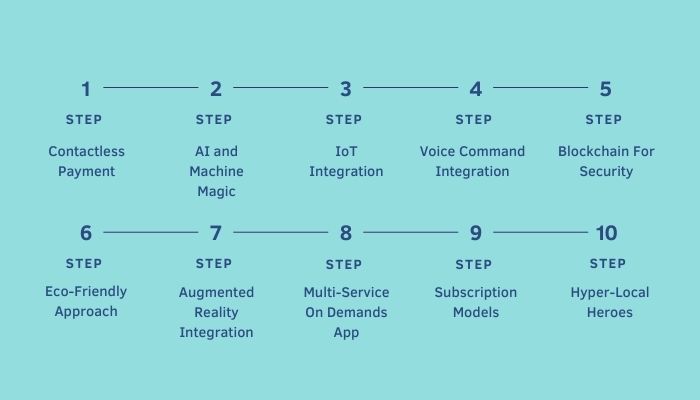
In the dynamic world of On-demand delivery apps, staying ahead of the curve is essential. Let’s explore the latest trends that are reshaping the industry and enhancing user experiences:
Step 1. Contactless Payment
In a world forever changed by the pandemic, contactless delivery options have surged in popularity.
You see, users appreciate the added safety and hygiene, making this trend a permanent fixture.
Moreover, expect contactless deliveries to remain a top priority, with innovations such as contactless payments and touchless drop-offs becoming the norm.
Step 2. AI and Machine Magic
Artificial Intelligence (AI) and Machine Learning (ML) are the powerhouses behind On demand delivery app optimization.
These technologies are being employed to predict user preferences, optimize delivery routes, and personalize the entire user journey.
From recommending favorite dishes to predicting delivery times accurately, AI and ML are transforming the way we receive services.
Step 3. IoT Integration
The Internet of Things (IoT) is entering the On-demand world with a bang.
Real-time tracking through IoT devices in delivery vehicles ensures that users can monitor their orders with pinpoint precision.
This not only enhances transparency but also contributes to more efficient logistics and better overall user satisfaction.
Step 4. Voice Command Integration
Voice assistants are taking center stage in On-demand app development.
Users can now place orders, track deliveries, and get assistance through voice commands, making the entire process hands-free.
As voice recognition technology advances, we can anticipate even more sophisticated voice-enabled features.
Step 5. Blockchain For Security
Blockchain technology is gaining traction for its unmatched security capabilities.
In the world of On-demand delivery, it’s being explored for secure transactions and supply chain traceability.
And users and businesses alike benefit from the transparency and trust that blockchain offers.
Step 6. Eco-Friendly Approach
Sustainability is no longer a buzzword; it’s a movement.
On-demand delivery apps are joining the green revolution by offering eco-friendly delivery options. Electric vehicles and bicycles are becoming commonplace for last-mile deliveries.
In addition to this, sustainable packaging and reduced carbon footprints are being actively promoted to cater to environmentally conscious consumers.
Step 7. Augmented Reality Integration
Augmented Reality (AR) is revolutionizing the shopping experience. You can virtually “try on” products before making a purchase decision.
Beyond that, AR is being used for navigation within large stores or shopping malls, ensuring users never get lost again.
Step 8. Multi-Service On-Demand App
On-demand apps are expanding their horizons by offering multiple services under one roof. The customer can now order food, book a ride, and schedule home cleaning all within a single app.
Furthermore, this trend simplifies user experiences and enhances convenience.
Step 9. Subscription Models
Subscription models are gaining momentum.
Users are opting for subscription-based services, which offer cost savings and exclusive perks. And expect more apps to explore this avenue to foster user loyalty and generate consistent revenue.
Step 10. Hyper-Local Heroes
Hyper-local delivery services are catering to specific neighborhoods or local communities.
This trend enhances convenience by offering tailored services that cater to the unique needs of a particular area.
It’s like having your neighborhood’s favorite stores and services at your fingertips.
Conclusion
On-demand delivery app development is not just about delivering services; it’s about delivering convenience and enhancing lives. It’s an exciting opportunity for businesses to ride the wave of consumer demand for quick, efficient, and hassle-free services. However, success in this realm requires careful planning, adaptability, and a commitment to delivering exceptional user experiences.





No Comments
Comments are closed.